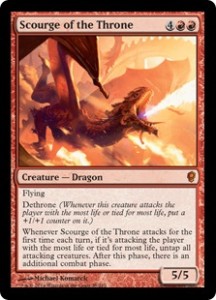A few weeks ago, I was lucky enough to have a weekend away from work, and I decided to spend it at SCG Dallas with a few friends. We headed down on Saturday afternoon, and while we had vague plans of playing in the Modern 5k on Sunday, we all knew the trip was mostly just to hang out and have a good time.
And good times were had, no doubt. But that’s not the point of this story. While we did spend some time on the floor, it was mostly to trade. Specifically, I was on a mission: to find the last two foils I needed for my Modern Merfolk deck: a foil Oboro, Palace in the Clouds and a foil Mikokoro, Center of the Sea. They may not look like much, but they’re lands that make blue mana that don’t die to Choke… At least that’s what I thought. As you may have noticed, Mikokoro doesn’t actually make blue mana, and it turns out the card I needed all along was Minamo, School at Water’s Edge. Somehow I got confused and mixed myself up and missed out on a chance to trade for one.
Anyway, I did manage to find an Oboro, and trading was had, with the usual rifling through each other’s binders and making small talk while we did so. My trade partner made a stop on a particular page of my binder, the one filled with a dozen or so Scourge of the Throne.
“That must be nice to have those, huh?” he prodded, referring of course to the small spike that Scourges went through a month or so ago.
“I guess so,” I replied.
And on paper, it is nice. I bought mine at $7 or so to fill a few orders at the LGS where I sell cards, and I grabbed a handful of extras in anticipation of Dragons of Tarkir. And it worked out great! After all, the card moved from $7 to $14 after I bought them. Must be nice, huh?
Today, those Scourges buylist for around $8. If I were to sell them, I would make about 75 cents a copy after shipping charges.
Not exactly paying the rent with that.
The Conversation That Started It All
“Marianne: So how did it go?
Me: It was okay. I went 3-1 playing, but I made like $30 trading!
Marianne: Great, so are you taking me out to dinner tomorrow night? Or are you going to buy me shiny things?
Me: Well, it’s more like “theoretical money.”
Marianne: So macaroni and cereal again?
Me: (sigh) Yeah, but I really like those!”
That’s what I wrote on December 22, 2010, when I was a dirt-poor sophomore in college just trying to put together some cards to play FNM (writing this makes me feel old). I’ve contributed a few things to the realm of “MTG finance” writing, but I consider the articulation of this concept the most important thing I’ve ever done in the field. Remember that in those halcyon days of 2010, smartphones weren’t a thing, trading was a great way to make value, Marianne and I weren’t yet married, and I loved eating macaroni and cereal (one of those four things still hasn’t changed, and I can report that we’re approaching our third wedding anniversary).
Another thing hasn’t changed. Then, like now, everyone wants to brag about their successful spec. “I just knew this card was going up!” people constantly shouted. Then when you see their binders full of the newly-expensive card (probably some garbage like Consuming Vapors, which was all the rage back then) and showing it off in the store. They would be so proud of themselves for getting in on the hot spec beforehand, and they would revel in all the money they made.
Twelve months later, I’d see that exact same binder when they came to sell to me, their Consuming Vapors now bulk again.
Tell me, did they really make any money?
The Myth of Making Money
Nothing, I repeat, nothing matters until you out a card. Whether that’s to a buylist or eBay for cash, or to another player in a trade, there is a hell of a lot more to making money on Magic cards than simply the price you acquire it for (your “in” price).
Your “out” price (the number you ultimately move it for) is even more vital. The difference between those two numbers (after shipping/fees of course) is the money you made on those cards. That’s it. It doesn’t matter how high or low the price went in the interim. If you didn’t move it when the price was higher, your $8 Consuming Vapors may as well have been $100 for all the good it did you.
It’s a lesson I learned the hard way in 2011, when I decided to speculate on Primeval Titan after the banning of Jace and Stoneforge Mystic in Standard. With the Caw-Blade menace leaving the format, things seemed wide open for the decks abusing Valakut, the Molten Pinnacle to return with force to the forefront. And I was quick to the party, getting my copies before the price predictably rose.
The only problem? I was racing the clock. A known reprint was coming in Magic 2012, and I was late in getting my copies listed and shipped. In the end I lost about $20 despite being “ahead” of the curve when the price spiked.
The Myth of Making Money™ strikes again.
It’s a lesson that people new to the finance scene seem to have to learn the hard way. Travis Allen went through the same experience last year (and made out better than I did), and wrote a great article about the experience.
The Myth of Making Money™. It strikes us all.
But it only has to strike once. Or, for those of you reading this today, hopefully not at all.
Avoiding the Trap
There are definitely a few ways to mitigate the risks that cost Travis and I so much.
Temper Your Expectations
First, have realistic expectations. If you see an $8 card and believe it can push $11 or $12, think twice before you buy into it. Using Scourge of the Throne as an example, it took the card nearly doubling up for me to break even on a buylist. And the truth is, if you’re speculating on a card to resell, buylists are likely going to be your best option if you bought more than a playset or two. Know that whatever you buy, you need to reasonably expect a double-up before you can expect to get your money back after shipping.
Trading
Trading for cards is a good way to eliminate some of the upfront costs, given that the “true value” of your $8 retail card is closer to $4 or $5 in cash. If you can use that card to pick up the $8 card you want to spec on, you’re getting yourself a much better deal than buying in it for actual dollars.
Go Deep
If you feel strongly enough about a card to move in on it, do it for enough copies to make it worth it. Having a playset of a card you knew was going to strike it big is great, and you’ll have those to play with, but if you do feel strongly, don’t be afraid to go deep. You have to risk it to get the biscuit, after all.
Account for All Costs
When I mention the costs here, I’m sure the first thing that came to your mind was postage. And it’s true, that is a major cost. But it’s far from the only one and, I would argue, not even the most important.
Your time is a cost, and your time is worth money. Spending time researching and buying a spec, or trading into it, is time you aren’t spending playing Magic or hanging out with your girlfriend or delivering pizzas for some extra cash. If you’re going to look toward this as a way to make a little money, you must absolutely account for the cost of your time.
Do It for the Story
I have one other piece of advice when it comes to speculating.
I’ve explained the Myth of Making Money™ today, and I hope it helps you understand that making money on “MTG finance” is not anywhere near as easy as some people paint it. It’s work, and it can be hard work with little reward. In almost all cases, your time is better spent delivering pizzas if you’re looking for some extra money.
But Magic can give you something that Pizza Hut can’t.
The memories.
Nobody is retiring off of money they made flipping some Magic cards over the weekend. But you may be able to foil out pieces of your Commander deck by doing so. And when someone comments on your cool signed foil Fifth Dawn Eternal Witness, what’s a better story: that you made enough money to get them from your out-of-right-field spec on Death’s Shadows, or that you delivered some pepperonis to buy it?
One of my favorite pieces to ever write was the story of how I sold my fetch lands that I had spent years acquiring through trade. In the end, I sold them for about $25 apiece, far from the heights they would later reach. But I don’t regret the decision. It was the completion of a story a long time in the making, and it’s one I remember vividly today. Hell, even stories where things go wrong (like my 94 Splinterfrights) are worth it for the story later. I keep that pile on my desk as a reminder that we can all screw up, no matter how long we’ve been doing this. Sure, I lost some money on that spec, but it’s a fun story anyway.
The Myth of Making Money™ is a vital concept for anyone getting into Magic finance to understand, and you won’t ever truly succeed in this field until you do. If you believe in a card and want to try your hand at speculating, don’t be afraid to do it. But make sure you give yourself a chance to succeed. And, for your own sake, enjoy it.
You may make some cash, or you may not make any money at all. Just make sure you make some memories along the way.
Thanks for reading,
Corbin Hosler
@Chosler88 on Twitter

